Technologies
Nintendo Switch OLED Review: The Best Switch, but Still Mostly the Same
Editor’s Choice: A bigger, better display and an excellent kickstand make this a great handheld game system, but existing Switch owners don’t need to upgrade.

I’m going to make this absolutely simple for you: The Switch OLED is the best Nintendo Switch there is, period. But your kids aren’t going to care. Or, at least, mine didn’t.
I learned this the hard way when I took the OLED-screen Switch downstairs to show my kids and got the Cold Hard Shrug of Indifference. My littlest kid wants a Switch he can fold up and put in his pocket. My older kid thought it was nicer, but also said he’s fine with the Switch he has. That’s the thing about the latest Switch update: The subtle upgrades are great, but they’re also more like things the original Switch should have had in the first place.
The newest version of the Switch is the most expensive: $350, or $50 more than the original Switch. Is it worth it? To me, yes. To my kids, no. But I’m old, my eyes are bad and I love the idea of tabletop game consoles.
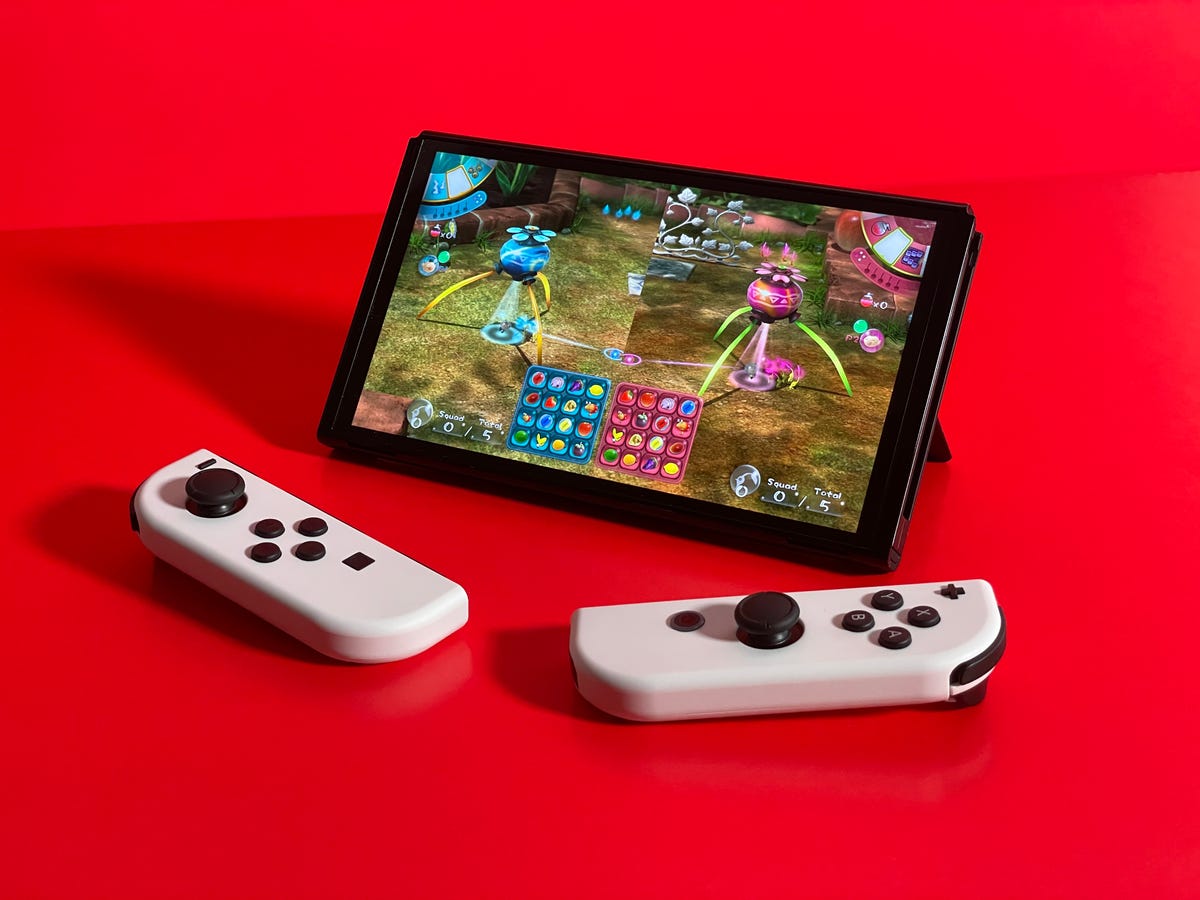
I bought a fancy Kindle Oasis midway through the pandemic. I already had a Kindle Paperwhite. I read a lot. The Oasis has a nicer, bigger screen. I don’t regret it. The Switch OLED is like the Kindle Oasis of Switches.
That bigger, more vibrant OLED display is obviously better. That’s why a lot of people at CNET (not me, though) have an OLED TV, and we’ve been talking about the advantage OLED brings to phones for years. (One thing I don’t know the answer to yet is if there are any concerns with screen burn-in.) If you play a lot of Switch games in handheld mode, and want the best experience, this is it. And now that I’ve played it for a week, I obviously like this Switch the best.
But the other way this shines is in the Switch’s third mode: tabletop mode.
Finally, a good tabletop Switch
I always wanted a Vectrex, an old game console from the ’80s that had vector graphics and looked like a self-contained mini arcade machine you’d stand up on a desk. I used to put iPads in little mini arcade cabinets. I love the idea of Arcade1Up’s Countercade retro machines.
The Switch has two clear gaming modes: handheld, and playing docked with a TV. But there’s another. Tabletop mode means you use the Switch as a propped-up screen and huddle around it with your detachable Joy-Con controllers. That mode has generally been lousy with the original Switch, because its flimsy kickstand is terrible and it only stands at one angle. The original Switch’s 6.2-inch screen is also better viewed from shorter distances, while tabletop gaming makes it feel too small for collaborative split-screen games.
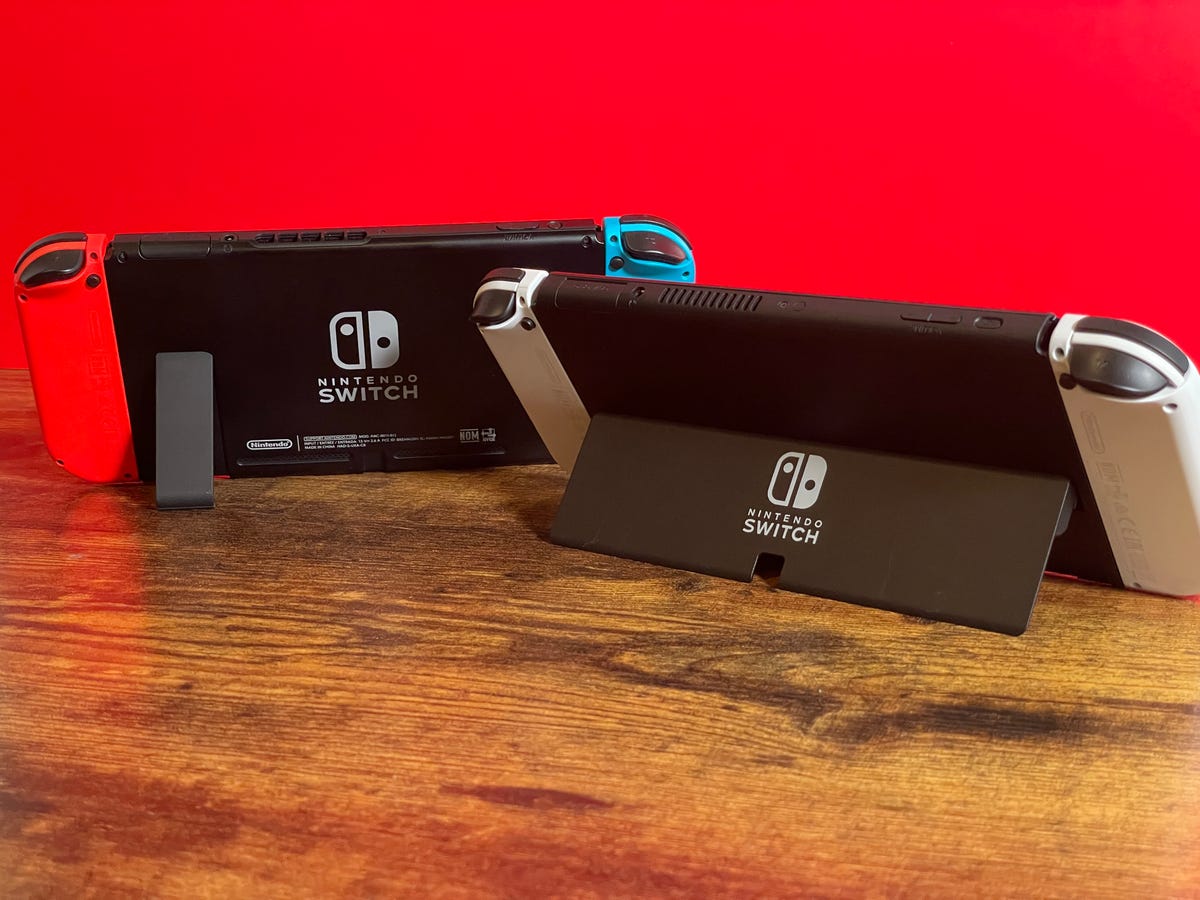
The 7-inch OLED Switch’s display is far more vivid and can show off small game details more clearly. Also, that rear kickstand is improved at long last. The pop-out plastic stand runs almost the entire length of the body, and can be adjusted to any subtle angle, from nearly upright to close to flat. Much like many iPad kickstand cases (or the Microsoft Surface Pro), it means it’s finally usable. It just makes sharing games on that screen a lot more fun for games like Pikmin 3, or board games like Clubhouse Games.
Look, for multiplayer games, you’ll still want to dock with a TV. The tabletop mode is really a niche third form. But if you’re traveling with kids, you may end up taking advantage of it a lot more than you thought (and it seems like an amazing thing to have for airline table gaming).
A bit bigger (but basically still the same size)
The OLED Switch is a bit bigger and heavier than the original Switch. Still, I was able to zip it into a basic carrying case I’ve used for the old Switch just fine. The slightly changed dimensions do mean it won’t slide into those old folding Labo cardboard items (if you care), and it’ll likely make other more closely tailored accessories and sleeves not fit. But so far it feels like using the older Switch, just better. There’s no change to how the Joy-Cons connect to the sides, so that’s the main thing.
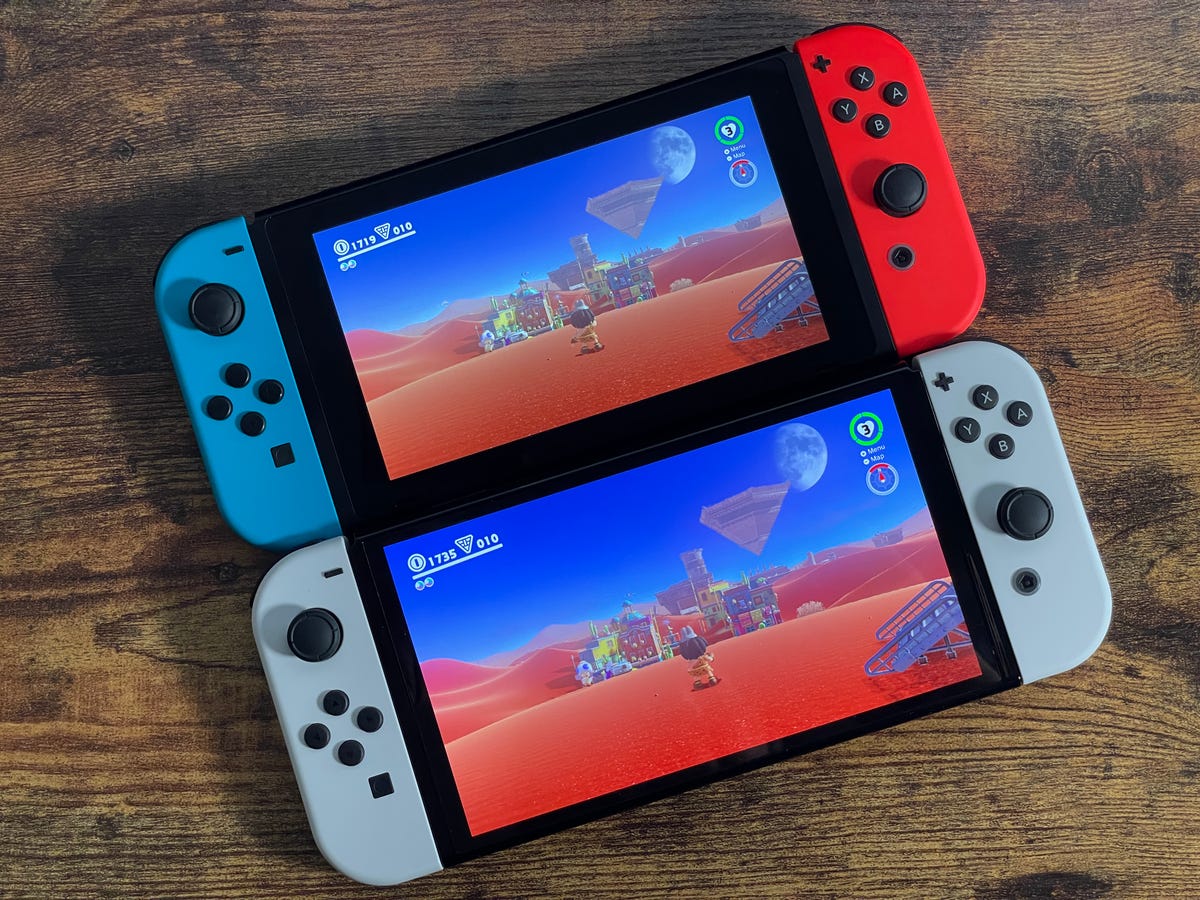
The display: Vivid, sometimes subtle
The larger 7-inch OLED display is, without a doubt, better. Colors are more saturated, which works really well with Nintendo’s bright and bold games. Metroid Dread, which I played on the OLED Switch, looks wonderful. So does Mario Kart 8 Deluxe, Luigi’s Mansion 3, Hades, Super Mario Odyssey, Untitled Goose Game, Zelda: Skyward Sword, WarioWare: Get It Together and nearly everything else I threw at it.
The bezels are smaller, and the whole thing feels more modern now. You can’t even see how much better the display looks in these photos (photos don’t easily tell the story with displays). But also, the jump to a 7-inch display isn’t the quantum leap experience.
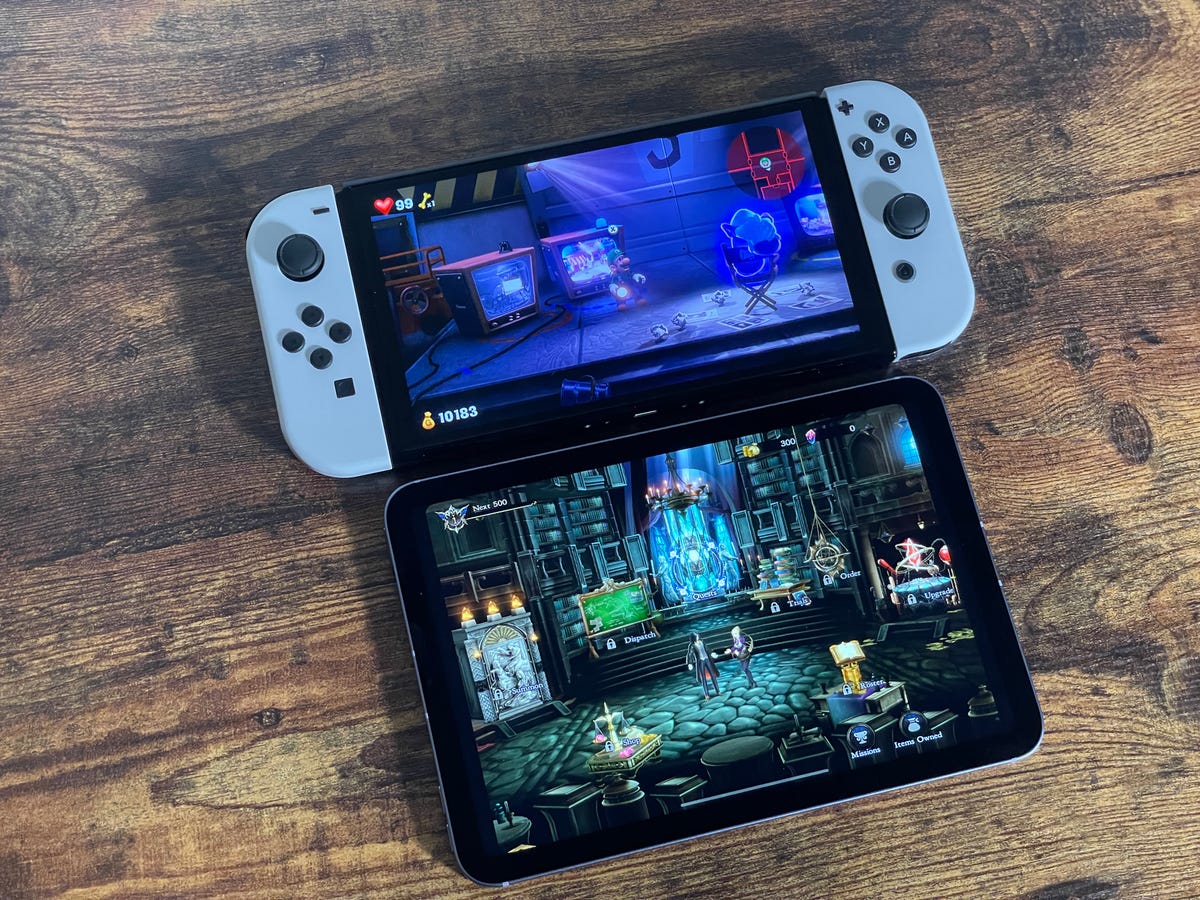
The recent iPad Mini has a larger screen, for instance. The 7-inch display looks better for all games, but it’s still sometimes a bit small for me and my tablet-based life. The 720p resolution is low for a 7-inch display, but really I never noticed that much.
One thing I do know: I don’t want to go back to the older Switch now. The display looks small and clearly worse, and the OLED display is already spoiling me.
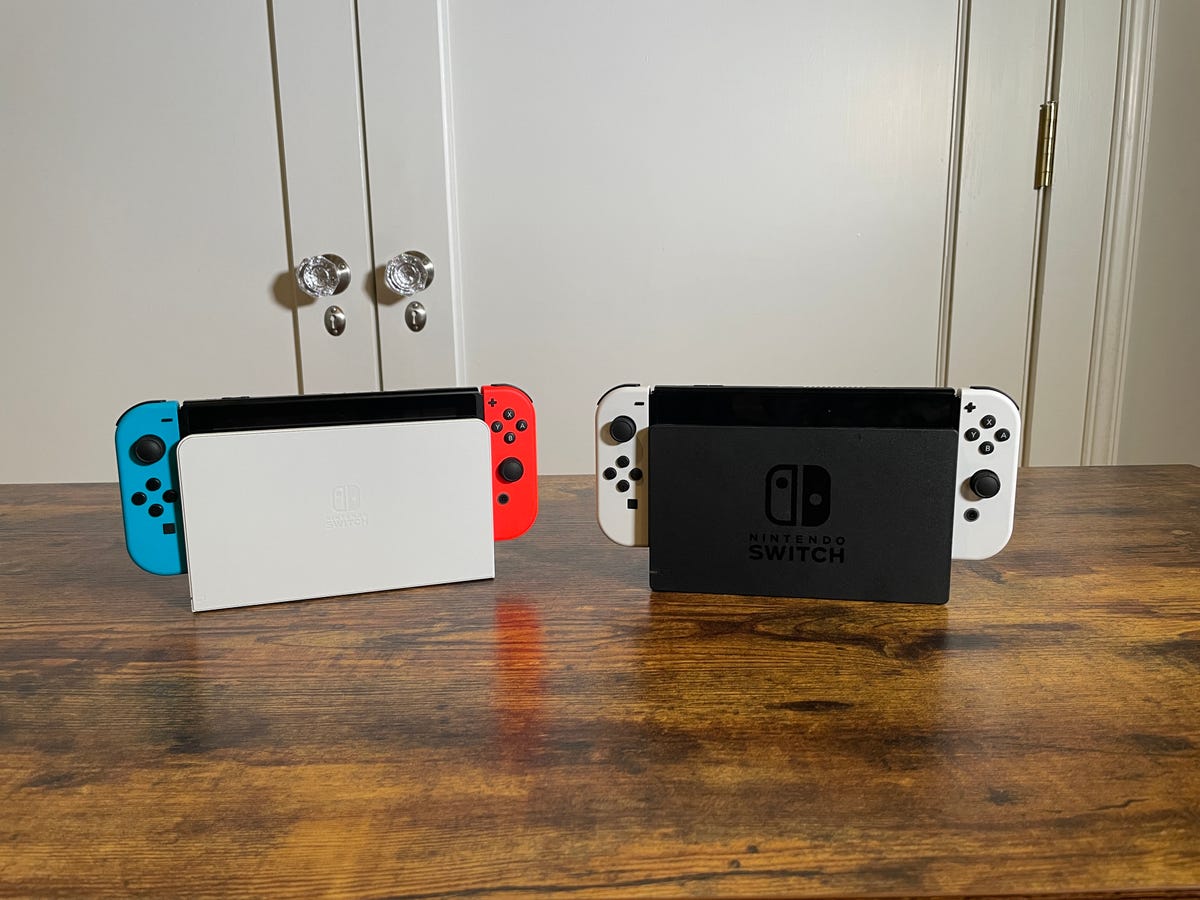
New dock, but also old dock
The new dock with the Switch OLED has an Ethernet jack now for wired internet connections, which isn’t anything I need but is helpful to have just in case, I guess. That jack means one internal USB 3 port is removed, but there are still two USB 3 ports on the outside. The pull-off rear dock cover is easier for cable access than the hinged door was previously. The dock is just for connecting the Switch to your TV, so if you’re a handheld-only gamer, that’s what that weird box with the slot in it is for.
But the new Switch works in old Switch docks, too. The new dock isn’t really all that new. (Although, new docks can get upgraded firmware — which might mean new features, but it’s hard to tell right now.)

It works with older Joy-Cons! (But Joy-Cons haven’t changed)
The Switch OLED can use any pair of Switch Joy-Cons you have lying around, just like always. That’s great news, except the Joy-Cons that come with the new Switch aren’t different, either. I got to try the new white-and-black model with its white Joy-Cons, but other than the color change, they have exactly the same features — and exactly the same feel. Joy-Cons, to me, have ended up feeling pretty old compared to the rock-solid and comfy Xbox and PS5 controllers. I wanted analog triggers, a better analog stick, less Bluetooth lag. And who knows if these seemingly similar Joy-Cons break as easily as older ones do.
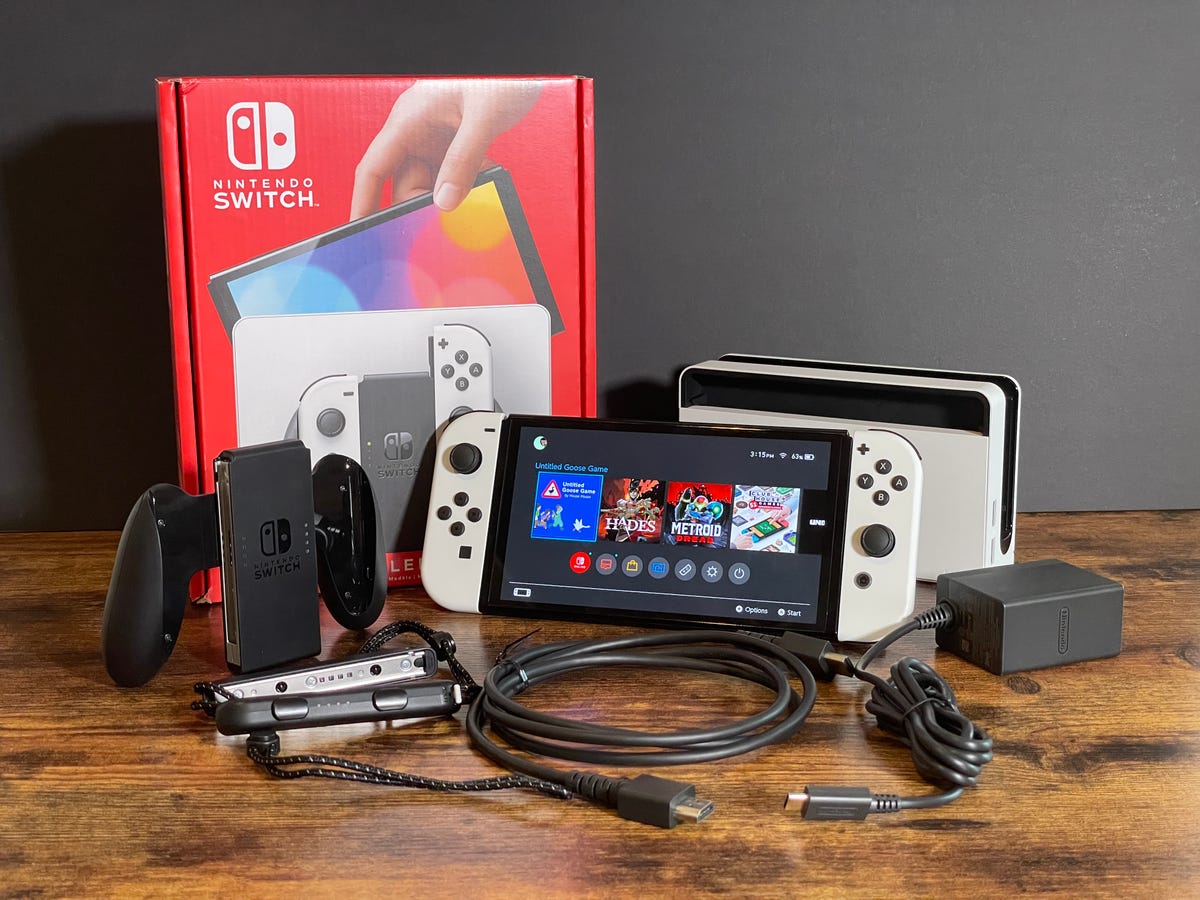
It runs quieter so far?
The fan on my older Switch sounds like a car engine: I think the fan’s broken, or damaged. The Switch OLED, so far, has seemed a lot quieter. There’s still a heat vent at the top, but I haven’t noticed any noise as much.
More storage (but still get a microSD card)
The 64GB base storage on the Switch OLED is a good bump from the 32GB that older Switches have, which is nice. I downloaded 13 games before filling it up: Switch digital games range from several hundred megabytes to over 10GB, but take up less space than PS5 or Xbox games. Still, there’s a microSD card slot on the Switch like always, and storage is cheap. Using an extra storage drive doesn’t require any special setup or lock you to specific brands, unlike PS5 and Xbox Series X storage expansions.
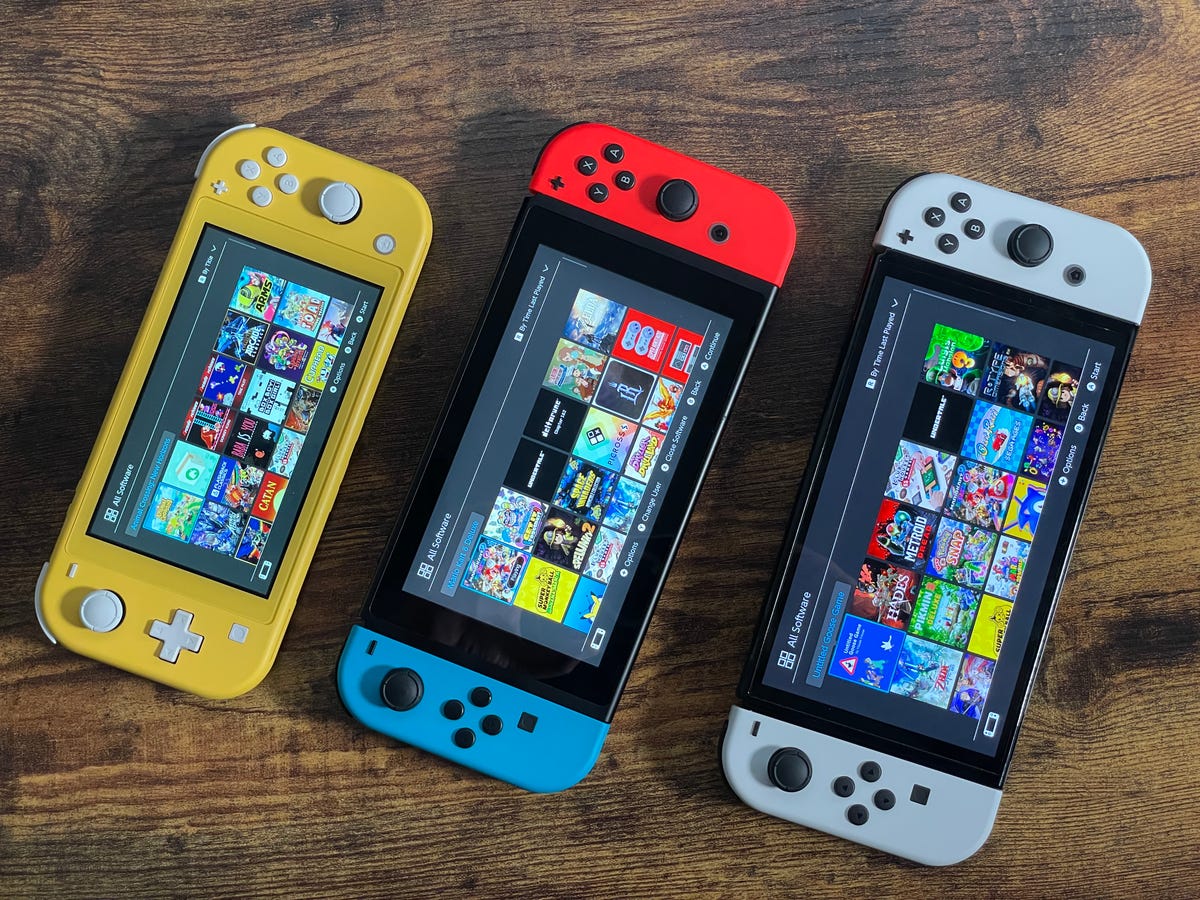
This is the one Switch I’d want. But it’s not necessarily one you need
For me, it’s clear the OLED Switch is the best Switch, based on specs alone. But that slightly bigger and brighter screen, those better speakers, the slightly different dock and the admittedly very nice new kickstand don’t really add up to a huge reason to upgrade if you have a Switch you’re happy with. The Switch still plays games just the same as it did before, and the exact same games. TV playing is identical.
A true Switch 2 hasn’t arrived yet, and may never arrive. Nintendo may just choose to slowly upgrade bits of the Switch over time, in the same way that phones slowly upgrade. At this point, the Switch OLED is the best version and the one I’d recommend for any new buyer. It’s worth the extra $50 if it’s your very first Switch.
We’re over five years into Nintendo’s Switch console lifecycle, and there are tons of great games. But, also, the Switch clearly lacks the graphics punch of next-gen consoles like the PS5 and Xbox Series X. Mobile games and iPad games keep getting better. There are a lot of ways to play games. The Switch is still a wonderful library of Nintendo and indie games and other stuff too, and a stellar family device, but it’s just one slice of an ever-growing gaming universe. Nintendo hasn’t leveled up its console yet — this still has the same processor as before and serves the same audience. Just consider it a revision that’s checked a bunch of features off our wish list. But not all of them.
Technologies
Today’s Wordle Hints, Answer and Help for Dec. 31, #1656
Here are hints and the answer for today’s Wordle for Dec. 31, No. 1,656.
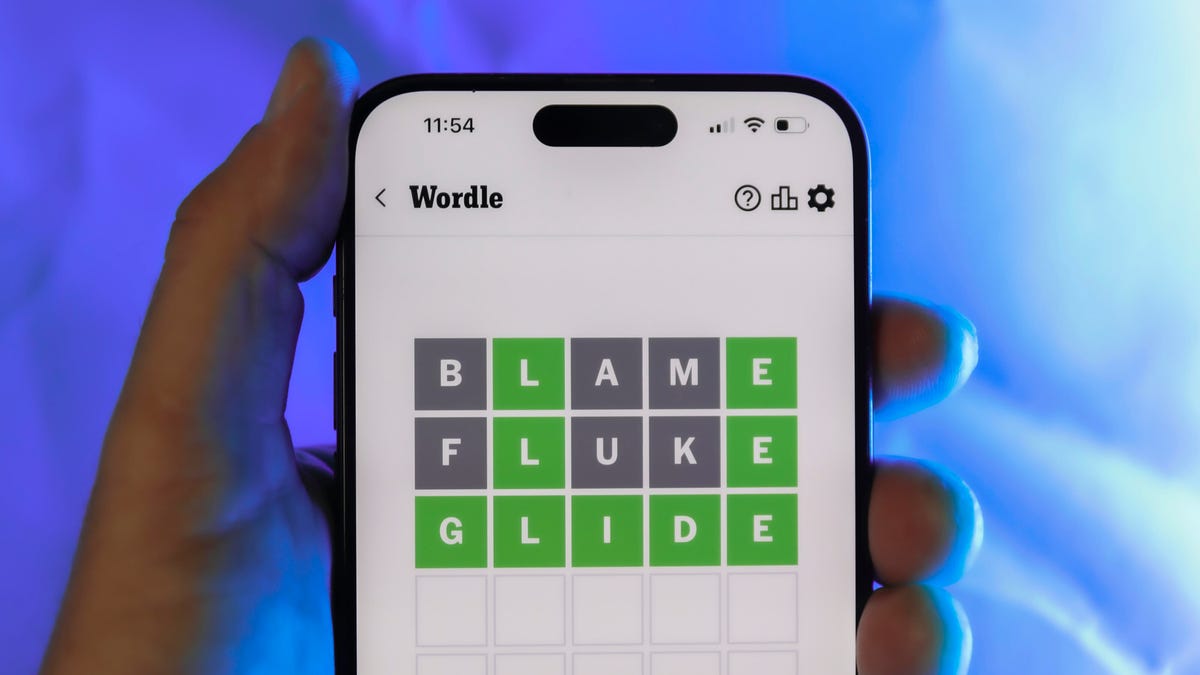
Looking for the most recent Wordle answer? Click here for today’s Wordle hints, as well as our daily answers and hints for The New York Times Mini Crossword, Connections, Connections: Sports Edition and Strands puzzles.
End the year with a Wordle win. Today’s Wordle puzzle isn’t terribly tough. If you need a new starter word, check out our list of which letters show up the most in English words. If you need hints and the answer, read on.
Read more: New Study Reveals Wordle’s Top 10 Toughest Words of 2025
Today’s Wordle hints
Before we show you today’s Wordle answer, we’ll give you some hints. If you don’t want a spoiler, look away now.
Wordle hint No. 1: Repeats
Today’s Wordle answer has no repeated letters.
Wordle hint No. 2: Vowels
Today’s Wordle answer has two vowels.
Wordle hint No. 3: First letter
Today’s Wordle answer begins with S.
Wordle hint No. 4: Last letter
Today’s Wordle answer ends with N.
Wordle hint No. 5: Meaning
Today’s Wordle answer can refer to a device that makes a loud, long-lasting sound as some kind of signal or warning.
TODAY’S WORDLE ANSWER
Today’s Wordle answer is SIREN.
Yesterday’s Wordle answer
Yesterday’s Wordle answer, Dec. 30, No. 1,655 was DECOR.
Recent Wordle answers
Dec. 26, No. 1651: SPEED
Dec. 27, No. 1652: BATCH
Dec. 28, No 1653: ABBOT
Dec. 29, No. 1654: FRUIT
Don’t miss any of our unbiased tech content and lab-based reviews. Add CNET as a preferred Google source.
Technologies
Today’s NYT Connections Hints, Answers and Help for Dec. 31, #934
Here are some hints and the answers for the NYT Connections puzzle for Dec. 31, No. 934.
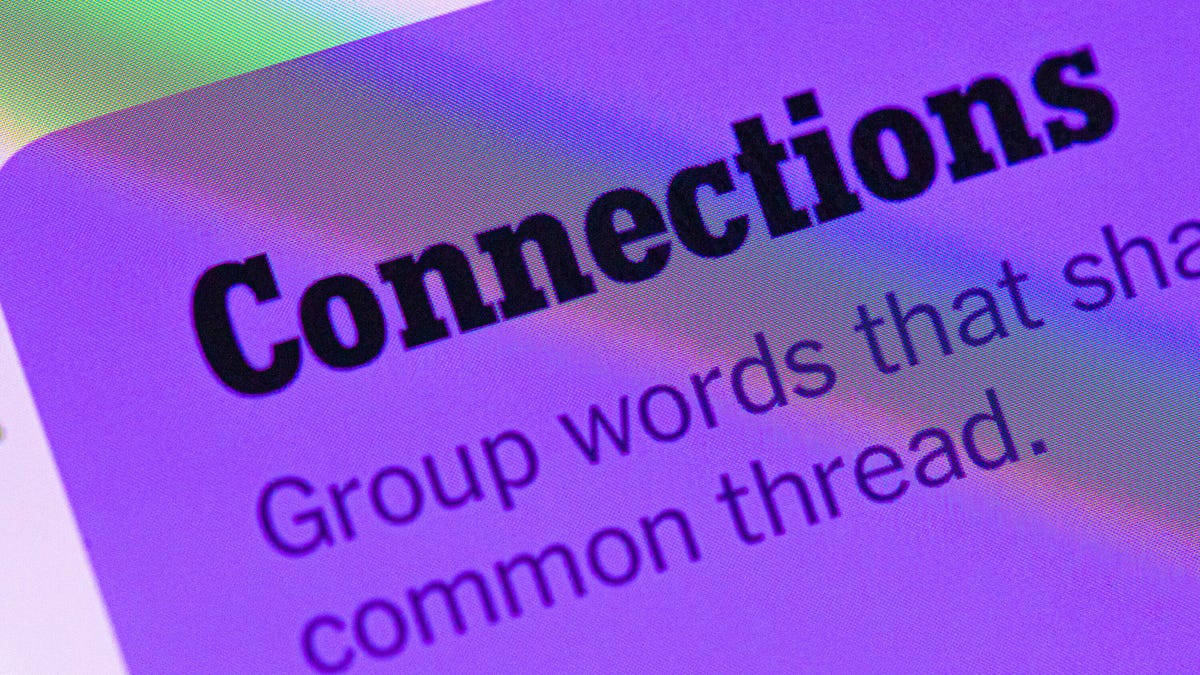
Looking for the most recent Connections answers? Click here for today’s Connections hints, as well as our daily answers and hints for The New York Times Mini Crossword, Wordle, Connections: Sports Edition and Strands puzzles.
Today’s NYT Connections puzzle has a tough purple category once again. But the yellow group is very timely, and pretty easy. Read on for clues and today’s Connections answers.
The Times has a Connections Bot, like the one for Wordle. Go there after you play to receive a numeric score and to have the program analyze your answers. Players who are registered with the Times Games section can now nerd out by following their progress, including the number of puzzles completed, win rate, number of times they nabbed a perfect score and their win streak.
Read more: Hints, Tips and Strategies to Help You Win at NYT Connections Every Time
Hints for today’s Connections groups
Here are four hints for the groupings in today’s Connections puzzle, ranked from the easiest yellow group to the tough (and sometimes bizarre) purple group.
Yellow group hint: Here comes 2026!
Green group hint: Where is it?
Blue group hint: Pennsylvania city.
Purple group hint: Waves.
Answers for today’s Connections groups
Yellow group: Happy New Year!
Green group: Places where things disappear.
Blue group: Associated with Philadelphia.
Purple group: Starting with bodies of water.
Read more: Wordle Cheat Sheet: Here Are the Most Popular Letters Used in English Words
What are today’s Connections answers?
The yellow words in today’s Connections
The theme is Happy New Year! The four answers are ball drop, champagne flute, fireworks and noisemaker.
The green words in today’s Connections
The theme is places where things disappear. The four answers are Bermuda Triangle, black hole, couch cushions and dryer.
The blue words in today’s Connections
The theme is associated with Philadelphia. The four answers are brotherly love, cheesesteak, Liberty Bell and Rocky.
The purple words in today’s Connections
The theme is starting with bodies of water. The four answers are bay leaf, channel surf, sea bass and sound barrier.
Don’t miss any of our unbiased tech content and lab-based reviews. Add CNET as a preferred Google source.
Technologies
Samsung’s $200 Galaxy A17 Brings Google’s Circle to Search to Its Lower-Priced Phone
While the AI features are nice to see at the lower price, the Galaxy A17 otherwise looks very similar to the phone it’s replacing.
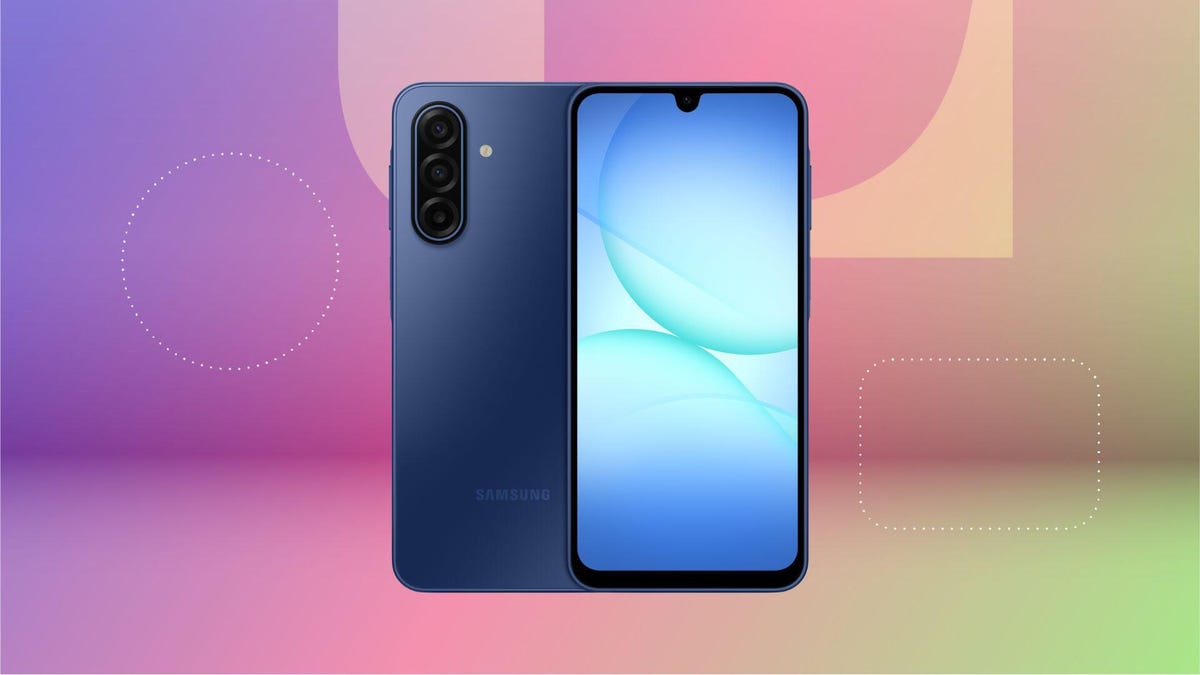
Samsung’s $200 Galaxy A17 5G, announced Tuesday, appears to be a smaller hardware refresh for the company’s lower-cost phone — bearing many similarities to the Galaxy A16 that it will replace. However, Samsung notes that the A17 will have access to several AI features, including Google’s Circle to Search and Gemini assistant.
Even though both of those AI features are becoming common on all phones running Android 16 (Motorola’s sub-$200 phones also include them), the Galaxy A17 might become one of the broadest ways that Circle to Search and Gemini reach new audiences. That’s because Samsung’s $200 phone is typically one of the few non-Apple devices to consistently top sales charts in the US, for instance, the $200 Galaxy A16 currently ranks fifth on Counterpoint Research’s list behind Apple’s iPhone 16 and iPhone 17.
Similar to the Galaxy A16, the A17 will have a 6.7-inch display with a 90Hz refresh rate, an IP54 rating for water and dust resistance (can withstand splashes but still avoid submerging the phone) and is powered by Samsung’s Exynos 1330 processor. The cameras are also the same, including a 50-megapixel wide camera, a 5-megapixel ultrawide camera and a 2-megapixel macro camera. Around the front is a 13-megapixel selfie camera.
The Galaxy A17 will also include a 5,000-mAh battery, 25-watt wired charging, 4GB of RAM with 128GB of onboard storage, the option to expand with a microSD card and will receive six years of software as well as security updates. That support period is quite notable for phones sold in the $200 range, as most phones that cost $200 get two to three years of updates.
The Galaxy A17 goes on sale in the US starting Jan. 7, and will come in blue, black and gray models.
-

 Technologies3 года ago
Technologies3 года agoTech Companies Need to Be Held Accountable for Security, Experts Say
-

 Technologies3 года ago
Technologies3 года agoBest Handheld Game Console in 2023
-

 Technologies3 года ago
Technologies3 года agoTighten Up Your VR Game With the Best Head Straps for Quest 2
-

 Technologies4 года ago
Technologies4 года agoBlack Friday 2021: The best deals on TVs, headphones, kitchenware, and more
-

 Technologies4 года ago
Technologies4 года agoVerum, Wickr and Threema: next generation secured messengers
-

 Technologies4 года ago
Technologies4 года agoGoogle to require vaccinations as Silicon Valley rethinks return-to-office policies
-

 Technologies4 года ago
Technologies4 года agoOlivia Harlan Dekker for Verum Messenger
-

 Technologies4 года ago
Technologies4 года agoiPhone 13 event: How to watch Apple’s big announcement tomorrow
